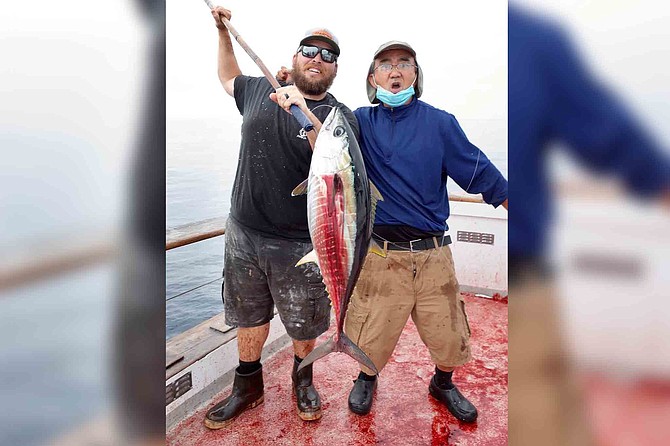
Old Glory Sportfishing
This happy angler with a solid yellowfin tuna aboard the Old Glory out of H&M Landing.
Dock Totals 9/5 – 9/11: 4,401 anglers aboard 198 trips out of San Diego landings this past week caught 16 barracuda, 1 black seabass (released), 977 bluefin tuna (up to 295 pounds), 436 bonito, 594 calico bass (263 released), 235 dorado, 6 halibut, 17 lingcod, 4,720 rockfish, 29 sand bass, 516 sculpin, 93 sheephead, 7 skipjack tuna, 1,557 whitefish, 2 white seabass (1 released), 845 yellowfin tuna, and 731 yellowtail.
Saltwater: It was pretty much a repeat of the week previous, with yellowfin tuna in the 20-to-40-pound range biting well on the high spots off the Baja coast between the border and San Quintin, yellowtail near the Coronado Islands, and a solid bite on very large bluefin tuna around the Tanner Bank at 90 to 110 miles west-northwest of Point Loma. The best action on yellowfin tuna and yellowtail offshore has been on live fly-lined sardines using 25-to-30-pound test line on medium-action gear, while the bluefin are being caught on flat fall irons, trolling, and kite or balloon-rigged live sardines, or preferably, flyers. Flyers are either a rubber imitation flying fish also known as ‘yummy flyers’, or frozen and thawed flying fish and are rigged so that when attached to a balloon or kite. Either by very slow trolling at a couple knots or drifting and using the wind, the bait or lure can be skipped across the swells to mimic a natural flying fish fleeing predators. In low wind conditions, a balloon filled with helium attached to a kite can provided the needed loft.
Two rods are used in this presentation. One, usually a shortened version of a trolling rod, controls the balloon or kite and can be let out and retrieved by a deckhand or tender, and the other rod is held by the angler and has the bait or lure, which is attached to the balloon or kite by a release clip similar to the clips used on outriggers. This keeps the bait on the surface while keeping the heavy leader that can often spook line-shy fish out of the water. When a fish strikes the bait, the line is pulled out of the clip and the angler is on. The balloon or kite is then retrieved while the first angler battles the fish. On sportboats with multiple passengers, other anglers will drop flat fall jigs or irons during the fight as the boat cannot generally move while an angler is engaged with a large tuna. This technique works very well to get the often-finicky bluefin triggered into feeding.
This past week, the kite-flyer tactic worked well for private boater Floyd Sparks out of San Diego. After boating a 200 pound bluefin tuna on the troll and a 175 pounder on the kite, another kite with a flyer drifted out produced a very large bluefin tuna at 395.4 pounds, which, if made official, would be a new state record.
For those targeting the bottom fish such as rockfish, whitefish, sculpin, and sheephead, squid or sardines presented dropper-loop style with enough weight to get down through the current has produced the best results. The dropper-loop is a simple 6-to-8-inch loop with a size 1 to 2/0 hook knotted about eighteen inches above the weight. Just let it drop to the seafloor, wind up one or two times to keep from snagging bottom, and slowly raise and lower the rod tip. Usually, the bait will be taken within a couple minutes if there are any biters in the area. For sheephead especially, frozen whole shrimp can work very well. California sheephead, also commonly called ‘goats’ or ‘poor man’s lobster’ for their crab-like tasting flesh, feed primarily on crustaceans, such as crabs, lobsters, and sea urchins around rocky reefs and kelp beds, with the larger fish coming from 60 to 150 feet deep.
California sheephead are protogynous hermaphrodites; all are born female with some changing into males by the time they are five years old. Females have a rounded head and are a solid orange in color and don’t usually exceed five pounds in weight. Those that change to males turn red and black and will have a forward-protruding lump on their head. Males can reach 35 pounds. With large canine teeth and crushing bone plates in their throats, these fish will often ‘raid’ the lobster pots, or traps, of commercial lobster operations, biting off legs or antennae sticking out through the wire mesh of the traps. Sheephead feed during the day and hunt by sight and scent, and if given time, will find a freshly thawed shrimp.
Fish Plants: 9/17, Santee Lakes, catfish (1,000)
"Yummy" - Google News
September 13, 2021 at 07:01AM
https://ift.tt/3zaNhip
Bloody Decks, Yummy Flyers, Monster Bluefin, and Poor Man’s Lobster - San Diego Reader
"Yummy" - Google News
https://ift.tt/3dchJOC
https://ift.tt/3c08sJp
Bagikan Berita Ini














0 Response to "Bloody Decks, Yummy Flyers, Monster Bluefin, and Poor Man’s Lobster - San Diego Reader"
Post a Comment